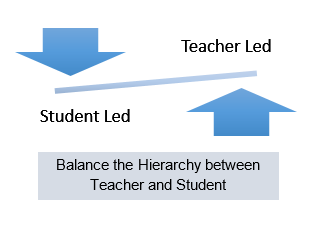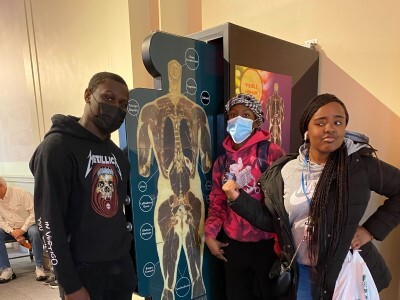New Designs for School
Transforming High School by Engaging Students in Co-Creating Powerful and Purposeful Learning Experiences
Topics

We’ve all had the experience of truly purposeful, authentic learning and know how valuable it is. Educators are taking the best of what we know about learning, student support, effective instruction, and interpersonal skill-building to completely reimagine schools so that students experience that kind of purposeful learning all day, every day.
As teachers at Vista High School shift to co-create learning experiences with students, students remind them they need to feel comfortable and connected to their teacher in order to learn.
Featuring Stuart Easton, teacher at Vista High School, and Vista High School students Ashley Alvarado, Vanessa Castillo, Lizzet Clemente, Cassandra Esparza, Michelle Garcia, Logan Gossard, Leslie Hernandez, Dayani Lujan, Aurelio Mercado, Nashelly Nava Cruz, Cristina Ramirez, Daniela Rojas, Alondra Solis Alatorre, and Kat Sciacca
The International Center for Educational Research and Practice (iCERP) promotes intersectionality of thought on a global scale. Nothing is more central to this focus than the transformation of the very fabric of education. We are all experiencing a shift in thinking and action around the learning pathways that students are taking; a shift that includes moving to a student-centered approach to education, where the students step away from their traditional role as recipients of core subject content and move into the driver’s seat of their quest to become flexible, nimble thinkers and learners in an increasingly complex society.
In this series about Vista High School, we place a laser focus on engaging student voice in various elements of transformation in education. The goal: to hear, first hand, how these changes are affecting the students’ lives as learners and future members of the global workforce.
This blog post focuses on the relationship between teachers and their students as they co-create learning experiences together. Check out this video to meet the students and their teacher, Stuart Easton, and learn more about their thinking as they assume autonomy over their learning pathway:
Co-Creation Leads to Increased Motivation
When students participate in co-creating the design of a project with a teacher, based on the teacher-generated choice of content, we increase the motivation and commitment to the demonstration of outcomes and expectations related to state standards and district and department expectations.
Teacher Challenge
To make co-creation possible, teachers need to respond to this guiding question: What can I do and what should I think about when I’m inviting students to co-create learning experiences with me for the first time?
As teachers at Vista High School plan for students to participate in co-creating the design of a project with them, they strive to envision what that process looks like. One key aspect of their work grappling with the guiding question is to see learning from both the student and teacher perspective.
| Teacher Planning Process Considerations | |
| Student Perspective | Teacher Perspective |
| I think you have heard the term "student voice" around the school. As you think about it, what does "student voice" mean to you? Where has your voice been important/valued and you feel you've been heard? How did that impact you as a learner? |
We have been talking about student voice and co-creation as we define personal learning. Where have you found some opportunities to include these elements in your design of learning experiences? Which Habits of Mind might be leveraged to support students in this process? In what ways have you made it possible for students to generate worthy questions for investigation? |
A Teacher Responds to the Challenge
My name is Stuart Easton. I am an English teacher at Vista High who participated in the student voice/co-creation activity. Although it was rewarding, fun, and inspiring, I will also admit that my first attempt at truly leveraging students’ voices to co-create powerful and purposeful learning experiences has been difficult on many levels. From these difficulties, I have identified three factors that must be considered while planning projects that invite students to co-create with the teachers:
- The students need to see relevance between the learning and their lives.
- The learning of the skills and dispositions is an ongoing process for everyone.
- The teachers and students need to see that the classroom hierarchy has shifted from a teacher-down experience to a teacher-and-student collaboration toward common goals.

I incorporated student voice into a lesson that was part of a recent unit exploring the idea of conformity. Students read an article called, “The Nacirema” (American spelled backward), in which it describes the strange rituals performed by an observed ‘tribe.’ When it was revealed that these were the habits of Americans and, therefore, potentially habits that the students themselves incorporated into their own daily lives, students admitted that they had participated in conforming to at least some of society’s norms for the sake of ‘not sticking out.’ Once students understood that conformity was a part of their own lives, this unsettling result led students to begin to question why humans conform in various situations. It also excited students to investigate character motivation within additional readings through the lens of conformity, often leading them to empathize more with characters who conformed out of fear, something that they had identified in themselves. Other students made connections of their experience to the movie, “The Stanford Prison Experiment,” they had seen on Netflix. Once again, they expressed a deeper connection with and understanding of characters they would have previously dismissed as different from themselves. The opportunity to empower student curiosity and student voice led to rich and more self-driven learning experiences as students experienced the relevance of the lesson’s big idea first hand.
Students have continued to focus their learning through this lens whenever they are examining character motivation in their readings due to this powerful and relevant experience. As they do, they engage in an ongoing process to refine the skills and dispositions needed to think in this critical manner. Additionally, a shift is occurring in the learning process; students are not waiting for instructions from the teacher to engage in learning but are using their developing ideas and understandings to shape the learning experience itself. The typical hierarchy between teacher and student is becoming a more level playing field.
Co-Creation as a Process
The process of the student voice/co-creation activity started when a group of students and I came together to outline the final expectations for the end of the current semester. While I provided the students the themes they would explore and the expectations that students would be required to demonstrate an understanding of, it was the students themselves who began the creation of the semester’s final project and the instructional plan needed to be able to demonstrate their learning. A key clarification was that I worked with students to monitor progress toward the expectations. Similarly, as we look forward, both the students and I will come together to modify their path toward expectations. Equally as important, I have promised to the students that the formative assessment and additional student learning will direct the activities created to ensure that their voices continue to impact the learning experience. Even when they are not planning lessons with me, they feel confident that their voices are still a part of the classroom.
When students were asked about the importance of leveraging their own voice, they all agreed that these efforts were essential and necessary and are having a positive impact on their motivation and efforts. Students also wanted their teachers to take into account that building a strong, positive relationship with students is the number one prerequisite for learning.
Positive Relationships are a Prerequisite for Learning
The central element of shifting to a co-created learning environment is to cultivate positive relationships with students. Kat Sciacca, a junior in another teacher’s U.S. History class said it best,
“I think it’s more important for the teacher to understand that in order for us to speak out and be more confident in giving our input in a project or in the classroom is that we’re comfortable with the teacher. We’re comfortable in the classroom of students. That we need to get to know each other first. My teacher, he just makes you feel really safe. He makes sure you’re understanding everything. It makes it really comfortable to talk to him.”
Leslie Hernandez’s perspective tries to explain the importance of building this relationship,
“I think it makes us feel important, matter, cared for, because we’re students. We have our own opinions. We go through stuff. We want someone to feel comfortable with.”
Alondra Solis Alatorre’s perspective embodies the fears of many students,
“It helps boost my confidence because before I was like, ‘I don’t want to talk.’ But then Stuckey [her teacher] would be like, ’So, Alondra, what do you want to add on?’ And then I would be able to talk. And because it was a smaller group also, I felt like I was not going to be judged and I was not going to make a fool of myself.”
Students also recognize that when their teachers take the time and put forth the energy required to build these relationships that the efforts have positive effects on learning. Cassie Esparza explained it this way,
“The better connection you have, the better we’ll do at learning the material, and speaking out, and coming through on what we need help with.”
Leslie Hernandez noticed a difference in the way her peers saw the co-created experience,
“They actually said they liked it. And it’s a good feeling to see that your peers also like the ideas.” Ashley Alvarado provided some specifics to help us better understand this thought, “We did a debate and you saw more kids, our peers, interested in it. They were actually talking. Because we have some peers that just stay quiet in class. And that day they were, like, on it.”
Vanessa Castillo spelled this out further,
“They were participating.”
Following this reflection upon how the co-created activity influenced their peers, Daniela Rojas added her perspective,
“I feel like they put in more time to certain activities and didn’t rush through it.”
Many students also see the building of these positive relationships as a sign of genuine respect between the teacher and themselves. Logan Gossard put it in these words,
“There is a weird thing that happens when respect is put into place. When students feel respected by teachers, it almost motivates them to want to do the work.”
Dayani Lujan echoed this sentiment,
“I feel more motivated and excited to do my work. I feel we do have a say and the teachers really are taking our feedback into consideration.”
She continued,
“I don’t think I’ve ever had a teacher bond like I do with them. And I feel like that makes the learning better. And I feel more comfortable in class.”
All the girls participating in this interview vocalized their agreement to this statement. But Nashelly Nava Cruz’s sentiment may say it best,
“I know, like, for me with other teachers, I don’t have that type of relationship with them. And that makes me not want to go to them when I have a problem, especially when it’s like a curriculum problem. I don’t feel comfortable asking teachers questions about what we’re learning. But when I’m with them, I do.”




